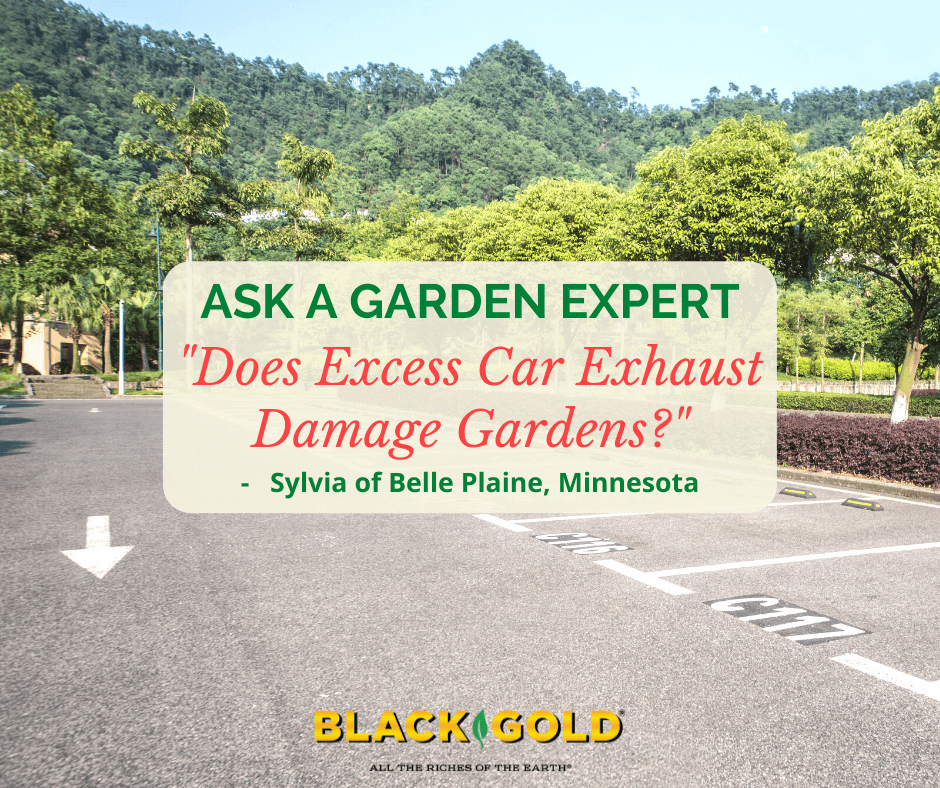“How would a parking lot with 16 stalls [and the car exhaust] next to my garden interfere with plant photosynthesis?” Sylvia of Belle Plaine, Minnesota
Answer: It is a very interesting question. Car exhaust contains gasses that are helpful to plants and photosynthesis and some that are harmful. Car exhaust is also everywhere, especially if you live in an urban area, though the increase in hybrid and electric cars is reducing car fumes. Still, nearby fumes may have some impact. Here is a breakdown of exhaust components from a standard car that runs on gasoline followed by the potential impacts of those gasses on plants and photosynthesis.
| Component | Emission Rate | Annual pollution emitted |
|---|---|---|
| Hydrocarbons | 2.80 grams/mile (1.75 g/km) | 77.1 pounds (35.0 kg) |
| Carbon monoxide | 20.9 grams/mile (13.06 g/km) | 575 pounds (261 kg) |
| NOx | 1.39 grams/mile (0.87 g/km) | 38.2 pounds (17.3 kg) |
| Carbon dioxide – greenhouse gas | 415 grams/mile (258 g/km) | 11,450 pounds (5,190 kg) |
(Click here for more exhaust gas details from Wikipedia.)
Carbon Dioxide and Plants
Here is the equation for photosynthesis as defined in Brittanica: 6CO2 + 6H2O → C6H12O6 + 6O2. Carbon dioxide is essential for photosynthesis, which is why it’s good to plant as many trees and garden plants as you can to help reduce this most abundant greenhouse gas. Plants take CO2 out of the atmosphere! Trees and large plants are highly effective photosynthesizers due to their sheer size, and grasses are super photosynthesizers, so consider planting a row of ornamental grasses (click here for some great ornamental grass options) or some trees and shrubs nearby to combat local CO2.
Carbon Monoxide and Plants
I found a technical overview of carbon monoxide in the atmosphere, which stated: “Carbon monoxide does not poison plants since it rapidly oxidizes to form carbon dioxide which is used for photosynthesis.” So, it is not harmful to plants either.
Nitrogen Oxides and Plants
Nitrogen oxides (NOx) contribute to smog, which blocks the sun’s rays, and acid rain, which is harmful to plants, so in excess, NOx is harmful to plants. Still, there is so much NOx in urban areas, the amount produced by the cars in the parking lot next to you would be negligible. On the plus side, you can plant nitrogen-fixing plants, such as plants in the pea and bean family as well as bayberry shrubs, to help with local NOx. These plants actively remove atmospheric NOx and convert it into a soil-borne form of nitrogen that benefits plants.
Hydrocarbons and Plants
In general, petroleum hydrocarbons are toxic to plants in high quantities, especially if they make their way into the soil (oil- or gasoline-contaminated soils). The cars nearby do emit hydrocarbons but in much lower quantities, so they should not be a problem for your garden.
As stated earlier, I recommend planting a tree, shrub, or ornamental grass buffer between your garden and the parking lot. Tough nitrogen-fixing options would be ideal! In addition to bayberry, try the following options suggested by my colleague Russell Stafford: “Outstanding legumes for perennial borders include false indigo (Baptisia spp.), wild senna (Senna spp.), yellow lupine (Thermopsis spp.), lupine (Lupinus spp.), and leadplant (Amorpha spp.). The roster of leguminous shrubs is also lengthy, boasting such standouts as bush clover (Lespedeza spp.)…” (Click here to read the full article.)
For general greenhouse gas information, I also recommend that you read this informative piece from the EPA about greenhouse gasses and their management (click here to read it).
I hope that this information is helpful!
Happy gardening,
Jessie Keith
Black Gold Horticulturist


